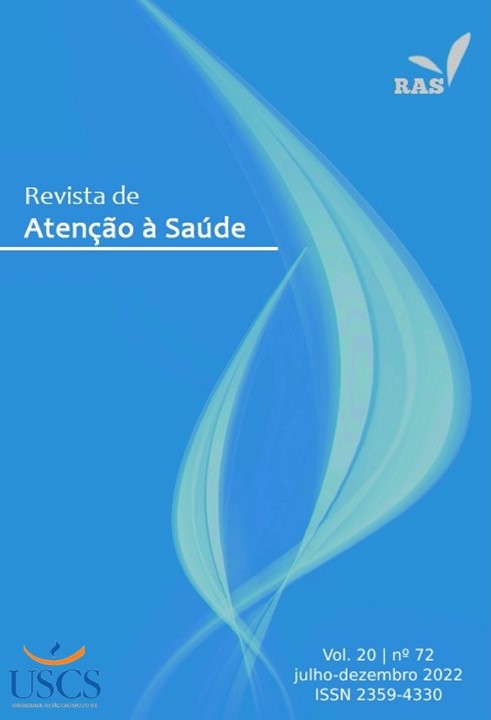STUDY OF THE PREVALENCE OF INTRINSIC AND EXTRINSIC FACTORS OF FALL RISK IN THE ELDERLY IN PRIMARY CARE
Study of the prevalence of risk factors for falls in the elderly in PHC
DOI:
https://doi.org/10.13037/2359-4330.8642Keywords:
Aged, Risk factors, PrevalenceAbstract
In Brazil, between 2000 and 2010, hospital admissions due to external causes, financed by the Sistema Único de Sáude (SUS), showed an increase of 19.1%, with falls as the main causes, especially among the elderly population, representing a problem public health on the rise. Objective: To investigate the prevalence of certain risk factors for falls in community-dwelling elderly people in PHC and their association with high intrinsic risk. Methods: Observational, cross-sectional study carried out with elderly people treated at the UBS Dr. Milton Lopes, Imperatriz/MA. Data collection was instrumental, using the modified Downton Scale, associated with a semi-structured instrument, analyzing aspects such as sociodemographic profile and elements considered risk factors for the occurrence of falls, in addition to the consequences of this grievance. The variables were associated using Pearson's chi-square test or Fisher's exact test, and values with p<0.05 were considered statistically significant. Results: A total of 182 elderly people were interviewed, with a mean age of 72.1 years, predominantly female (62.1%). There were a large number of reports of previous falls (48.4%), medication use (74.7%) and sensory deficits (81.9%) in this population. A prevalence of high intrinsic risk for falls was found in 53.85% of the sample. Among those who have already fallen, a good portion suffered skin injuries (25%) and/or fractures (20.4%). Conclusion: Comprehensive and priority assistance by public health services is suggested, aiming at the identification of populations at increased risk and the prompt establishment of preventive strategies in this area.
Downloads
References
Agência de Notícias do IBGE [internet]. Número de idosos cresce 18% em 5 anos e ultrapassa 30 milhões em 2017 [acesso em 24 de setembro de 2019]. Disponível em: <https://agenciadenoticias.ibge.gov.br/agencia-noticias/2012-agencia-de-noticias/noticias/20980-numero-de-idosos-cresce-18-em-5-anos-e-ultrapassa-30-milhoes-em-2017>.
Miranda GMD, Medes ACG, Silva ALA da. O envelhecimento populacional brasileiro: desafios e consequências sociais atuais e futuras. Rev Bras Geriatr Gerontol. Junho de 2016; 19(3):507-519.
Rigotti JIR. Transição demográfica. Educ Real. Agosto de 2012; 37(2):467-490.
Nogueira LV, Silva M de O, Haagen MVD, Santos R de CCS, Rodrigues EL de S. Risco de quedas e capacidade funcional em idosos. Rev Soc Bras Clin Med. Junho de 2017; 15(2):90-93.
Abreu DR de OM, Novaes ES, Oliveira RR de, Mathias TA de F, Marcon SS. Internação e mortalidade por quedas em idosos no Brasil: análise de tendência. Ciênc. saúde coletiva. Abril de 2018; 23(4):1131-1141.
Rubenstein et al, 1990, apud Paixão Júnior e Heckman, 2006, p. 954.
Freitas EV de, et al. Tratado de geriatria e gerontologia. 3 ed. Rio de Janeiro: Guanabara Koogan, 2013.
Fhon JRS, Rodrigues RAP, Neira WF, Huayta VMR, Robazzi ML do CC. Queda e sua associação à síndrome da fragilidade no idoso: revisão sistemática com metanálise. Rev Esc Enferm USP. Dezembro de 2016; 50(6):1003-1010.
Freitas R de, Santos SSC, Hammerschmidt KS de A, Silva ME da, Pelzer MT. Cuidado de enfermagem para prevenção de quedas em idosos: proposta para ação. Rev bras enferm. Junho de 2011; 64(3):478-485.
Ramos LR, et al. Polifarmácia e polimorbidade em idosos no Brasil: um desafio em saúde pública. Rev Saude Publica. Dezembro de 2016; 50(Suppl 2):9s.
Buksman S, Vilela ALS, Pereira SRM, Lino VS, Santos VH. Quedas em idosos: prevenção. Sociedade Brasileira de Geriatria e Gerontologia, [s. l]. Outubro de 2008.
Luiz IC, Brum AKR. Intrinsic factors for the risk of fall of the elderly at home: a descriptive study. Online Braz j Nurs. Agosto de 2018; 16(4):480-485.
Soares AT, Cabral KN. Como abordar o idoso que cai. Sociedade Brasileira de Geriatria e Gerontologia [acesso em 12 de outubro de 2019]. Disponível em: <https://sbgg.org.br//wp-content/uploads/2014/10/abordar-idoso.pdf>.
Barbetta PA. Estatística aplicada às ciências sociais. Ed. UFSC; 2008.
Fhon JRS, Rosset I, Freitas CP, Silva AO, Santos JLF, Rodrigues RAP. Prevalência de quedas de idosos em situação de fragilidade. Rev Saúde Públ. Junho de 2013; 47(2):266-273.
Siqueira FV, Facchini LA, Piccini RX, Tomasi E, Thumé E, Silveira DS, et al. Prevalência de quedas em idosos e fatores associados. Rev Saúde Pública. Outubro de 2007; 41(5):749-756.
Perracini MR, Ramos LR. Fatores associados a quedas em uma coorte de idosos residentes na comunidade. Rev Saúde Pública. Dezembro de 2002; 36(6):709-716.
Ferreira DC de O, Yoshitome AP. Prevalência e características das quedas de idosos institucionalizados. Rev Bras Enferm. Dezembro de 2010; 63(6):991-997.
Fabrício SCC, Rodrigues RAP, Junior ML da C. Causas e consequências de quedas de idosos atendidos em hospital público. Rev Saúde Pública. Fevereiro de 2004; 38(1):93-99.
Lacerda CF, Silva LO e, Canto RS de T, Cheik NC. Efeitos da adaptação às próteses auditivas na qualidade de vida, no equilíbrio e no medo de queda em idosos com perda neurossensorial. Int Arch Otorhinolaryngol. Junho de 2012; 16(2):156-162.
Duarte, GP. Fatores intrínsecos relacionados às quedas de idosos do município de São Paulo, segundo o Estudo SABE. 2010. 64 f. [dissertação]. Ribeirão Preto: Faculdade de Medicina de Ribeirão Preto, Universidade de São Paulo.
Costa AG de S, Oliveira AR de S, Moreira RP, Cavalcante TF, Araujo TL de. Identificação do risco de quedas em idosos após acidente vascular encefálico. Esc Anna Nery. Dezembro de 2010; 14(4):684-689.
Ministério da Saúde e Instituto Nacional de Traumatologia e Ortopedia (INTO). Queda de idosos. Biblioteca Virtual em Saúde do Ministério da Saúde, 2009.
Pereira AMM. A queda e suas consequências para o idoso: aspectos psicológicos e emocionais. 2006. 80 f. [dissertação]. Uberlândia: Universidade Federal de Uberlândia, Programa de Pós-Graduação em Psicologia.
Downloads
Published
Issue
Section
License
Copyright (c) 2023 Victor Rangel Pinheiro Neiva, Raquel Loiola Gomes Moreira

This work is licensed under a Creative Commons Attribution-NonCommercial-NoDerivatives 4.0 International License.
Policy Proposal for Journals offering Free Delayed Access
Authors who publish in this magazine agree to the following terms:
- Authors maintain the copyright and grant the journal the right to the first publication, with the work simultaneously licensed under a Creative Commons Attribution License after publication, allowing the sharing of the work with recognition of the authorship of the work and initial publication in this journal.
- Authors are authorized to assume additional contracts separately, for non-exclusive distribution of the version of the work published in this magazine (eg, publishing in institutional repository or as a book chapter), with the acknowledgment of the authorship and initial publication in this journal.
- Authors are allowed and encouraged to publish and distribute their work online (eg in institutional repositories or on their personal page) at any point before or during the editorial process, as this can generate productive changes, as well as increase impact and citation of the published work (See The Effect of Open Access).









